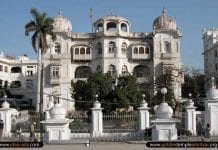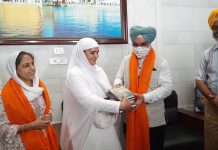


Abbotsford, BC—When the Gur Sikh Temple opened in Abbotsford in 1911, there were only 2,300 Sikhs in all of British Columbia.
On Sunday, at least that many people showed up for a parade celebrating its 100 years of serving the community.
The gurdwara, believed to be the oldest still-standing Sikh temple in North America, opened the doors to its archives on the main floor so people could see photographs from the community’s long history.
Pioneers working in B.C.’s forestry and farming industries began building the temple in 1908, using lumber donated by a local mill. At that time, Sikhs in Canada were nearly all men because immigration policies restricted their wives and children from joining them in the country.
“This temple is a great gift to the Sikh community,” said Gurdev Sidhu, 71, as he stood chatting with friends outside the simple white, three-storey building.
“I came into this country in 1969 and settled in Mission. At that time, we struggled to get more people, to provide more services, and we’ve come a long way.”
Free samosas and water bottles were handed out as the parade wound its way from the temple down South Fraser Way to Rotary Stadium, where speakers continued the celebration.
Throngs called out traditional Punjabi greetings, each time met with a cheerful traditional response.
Though the crowd was predominantly Sikh, people of all ages and ethnicities joined in.
Paul Wolbeer, 58, who works in a warehouse with many Sikhs, took in the parade on his birthday and as a way to pay respect to that community.
“There were a lot of hardships when [the Sikh pioneers] first came to Canada,” Wolbeer said.
An immigrant himself, Wolbeer moved to Canada from Holland as a child who spoke no English.
“At that time I felt a minority and I can relate to that feeling,” he said.
Sikhs in Abbotsford are no longer alone, as roughly one out of every five residents follows the religion.
They are the largest religious group in the city, slightly bigger than the Roman Catholic population.
Across the province, there are more than 150,000 Sikhs — half of all Canadians practising that religion.
“Initially I wasn’t even going to come,” said 35-year-old Maninder Dhesi as she stared at pictures of pioneers cutting trees.
“But now walking through here, it’s quite touching to see what happened over the years to these people who came here with nothing and what they were able to put together.”
On a floor above the archives a priest offered parsad — a holy food made of sweet flour— to visitors like Jas Mannan, 20, who made the trip from Surrey with his family.
Mannan moved to Canada from India in Grade 3 and said he appreciated the path those early pioneers blazed, a path much easier for today’s immigrants.
“There’s a lot of your own culture here, and you don’t feel like you’re away from your own country,” said the criminology student. “It’s my first time here and it’s really amazing to see.”
The festivities began in the morning with a visit from Prime Minister Stephen Harper and Premier Christy Clark.
The temple was restored in 2007 with a $1-million federal grant and is the first national historic monument without English or French heritage.




